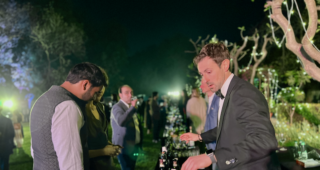Consider the following real world wine scenarios:
# 1: At a national day celebrations of a major wine producing country, guests are appalled to find warm red wines and unmindful pouring by servers mixing wines in the glasses. In the mêlée, somebody quips that the country might as well come up with an in situ rosé blend by mixing a red and a white in the glass itself!
# 2: Entertaining a foreign guest at an upmarket fine dining outlet in Lodi Road New Delhi, the guest and I look at each other in disbelief when the steward fills the glass three fourths with the Sancerre we had ordered- prompting me to suggest sharing the already poured measure rather than having the other glass poured.

# 3: A good friend is innocently about to put two ice cubes in a red wine to chill it the same way as he would, a whisky. Only to be stopped by his buddy explaining why it would be better to put the bottle in fridge for some time.
Each of the above scenarios are different yet the subject is common- wine service- an aspect vital to wine enjoyment. None can deny that the level of wine service can make or mar a wine. Imagine an over chilled full bodied red refusing to open up until you have warmed its cockles by cupping the goblet. Or a warmer than permissible white that tastes flabbier when it should be refreshing your palate. In short, service is to wine what a rack is to a pinion!
The Importance of Service in Wine
But why is wine service so fussed about? Why don’t we micro manage service to the same degree with other drinks?
Reasons may be many but to summarise, we can say that wine has more number of production variables than possibly any other beverage in the world. With approximately 1400 documented wine grape varietals* , the concept of terroir (a collective French term for soil type, micro climate and production methods) and propensity to evolve even during storage, wine turns out to be a complex entity that requires a little more deliberation than other beverages.
However all these variables do not mean that ultra special skills have to be acquired to serve wine. One can equate learning to serve wine with operating a home gadget. It can be operated straight out of the box or after taking some time to read the supplied manual to get access to its full functionality. Similarly, wine can well be enjoyed just by opening the bottle, but it helps if you know how to serve it optimally.
Professionally Speaking

In a professional scenario though, things are not that simple. Bad wine service when speaking professionally can have far reaching implications than meets the eye. For illustration, let us revisit the first two scenarios in the beginning of this post that fall under the professional domain:
Scenario 1 (National Day)
Being the national day of a country, a good range of wines from that country were offered to the guests amid a vast spread. Since the wine service was pathetically short, the wine savvy chose to switch over to other drinks while others just pulled along. In the aftermath, passionate wine lovers pointed out the glaring mistakes on social media kicking off a stimulating discussion- only to be snubbed by the hosts implying that a gift horse cannot be looked into the mouth! The protests died almost instantaneously lest one landed on the wrong side of the embassy’s goodwill. In this whole development an important lesson was lost- faulty wine service due to poor management and the opportunity cost to the presented brands that did not get a fair chance to be showcased in front of potential clients.
Scenario 2 (Restaurant)
The steward apologized profusely- to be joined by his manager who offered a complimentary dessert to compensate the deficiency in service. Disappointment assuaged, we declined his thoughtful offer and went on with our meal, which eventually turned out to be a good experience- the initial fiasco ignored.

Response is the Key
In each of the above scenarios, the host’s response was the key to salvage or worsen the situation. In the first scenario, the hosts may have felt that in the larger ambit of their national day celebrations, guests needn’t have been critical of the wine service, but they ignored the disservice they did to the affected brands rather than promoting them- which was their onerous responsibility. A simple acknowledgement of the lapse, may be on a humorous note, could have put the issue to rest and given the brands a second chance in the eyes of potential customers.
In the second scenario, even though the steward erred initially, the situation was salvaged with an apology and a sincere intent to address the consumer’s concern. Had it not been so, the restaurant might have lost valuable customers.
To conclude, wine service may not be quantum physics but it does require a certain level of planning and careful execution particularly in the professional context. And above all, a positive attitude to improve things when they indeed go wrong.
As for the third scenario above, the ‘faltering’ friend teasingly went ahead with putting the ice cubes in the wine. Now that is an entirely different equation beyond the realm of wine propriety.
* Data Source: Wine Grapes Edition 2013 by Jancis Robinson, Julia Harding and José Vouillamoz









